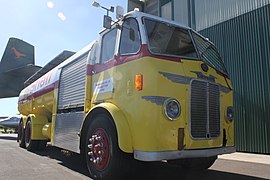
A semi-trailer truck, also known as a semi-truck, (or semi, big rig, tractor-trailer, or eighteen-wheeler) is the combination of a tractor unit and one or more semi-trailers to carry freight. A semi-trailer attaches to the tractor with a type of hitch called a fifth wheel.

DAF Trucks is a Dutch truck manufacturing company and a division of Paccar. DAF originally stood for van Doorne's Aanhangwagen Fabriek. Its headquarters and main plant are in Eindhoven. Cabs and axle assemblies are produced at its Westerlo plant in Belgium. Some of the truck models sold with the DAF brand are designed and built by Leyland Trucks at its Leyland plant in the United Kingdom.

Leyland Motors Limited was a British vehicle manufacturer of lorries, buses and trolleybuses. The company diversified into car manufacturing with its acquisitions of Triumph and Rover in 1960 and 1967, respectively. It gave its name to the British Leyland Motor Corporation, formed when it merged with British Motor Holdings in 1968, to become British Leyland after being nationalised. British Leyland later changed its name to simply BL, then in 1986 to Rover Group.

Associated Equipment Company (AEC) was a British vehicle manufacturer that built buses, motorcoaches and trucks from 1912 until 1979. The name Associated Equipment Company was hardly ever used; instead it traded under the AEC and ACLO brands.
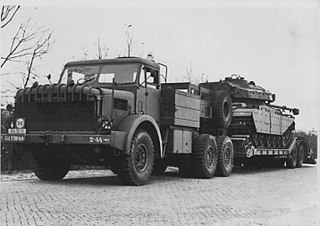
The Mighty Antar was a heavy-duty 6×4 tractor unit built by Thornycroft from the late 1940s onwards. For some decades it was the standard tank transporter of the British Army and was also used by other nations. It was powered by a shortened V8 land version of the V12 Meteor engine, derived from the Merlin and modified to run on diesel, known as the Rolls-Royce Meteorite.

Seddon Atkinson Vehicles Limited, a manufacturer of large goods vehicles based in Oldham, Greater Manchester, England, was formed after the acquisition in 1970 of Atkinson Vehicles Limited of Preston by Seddon Diesel Vehicles Limited of Oldham. In 1974, the firm was acquired by International Harvester, which sold it in March 1984 to the Spanish group Enasa which made it a subsidiary of Pegaso. In 1990, it became part of Iveco which used the brand for various types of specialised vehicles in the United Kingdom. The range of models produced included EuroMover, Pacer and Strato, which are aimed at refuse collection, recycling and construction operators.

Thornycroft was an English vehicle manufacturer which built coaches, buses, and trucks from 1896 until 1977.
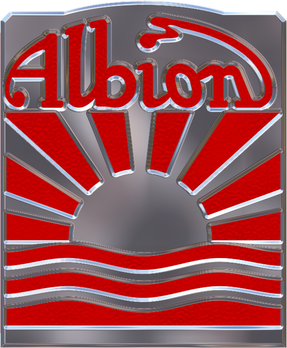
Albion Motors was a Scottish automobile and commercial vehicle manufacturer.
Scammell Lorries Limited was a British manufacturer of trucks, particularly specialist and military off-highway vehicles, between 1921 and 1988. From 1955 Scammell was part of Leyland Motors.

Guy Motors was a Wolverhampton-based vehicle manufacturer that produced cars, lorries, buses and trolleybuses. The company was founded by Sydney S. Guy (1885–1971) who was born in Kings Heath, Birmingham. Guy Motors operated out of its Fallings Park factory from 1914 to 1982, playing an important role in the development of the British motor industry.
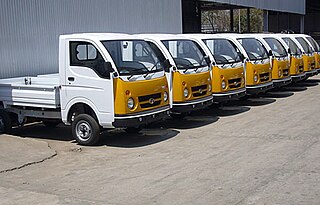
Tata Ace is a model of mini trucks manufactured by Tata Motors. It was launched in 2005.

Motor Rail was a British locomotive-building company, originally based in Lewes, Sussex, they moved in 1916 to Bedford. Loco manufacture ceased in 1987, and the business line sold to Alan Keef Ltd of Ross-on-Wye, who continue to provide spares and have built several locomotives to Motor Rail designs.

Morris Commercial Cars Limited was a British manufacturer of commercial vehicles formed by William Morris, founder of Morris Motors Limited, to continue the business of E G Wrigley and Company which he purchased as of 1 January 1924.

Willème was a French truck manufacturer.
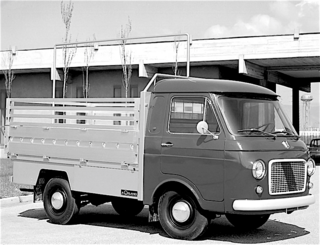
The Fiat 241 is a van produced by Fiat between 1965 and 1974. It has a payload over 1400 kg and was available in various formats like truck, van and bare chassis after the production of the 1100T pickup ended a year ago.
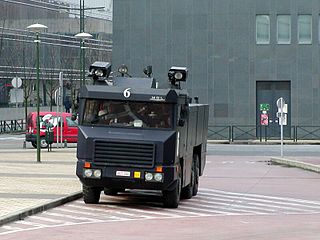
MOL is a manufacturer of specialist trucks and trailers, based in Hooglede, Belgium.Specilizes in manufacturing of trailers, waste vehicles, port equipement, trucks and rail equipments.

Nicolas Industrie S.A.S. is a French manufacturer of heavy trucks, trailers, HMT and SPMTs, mostly intended for oversize loads. Nicolas has been located in Champs-sur-Yonne since 1969, which is also when they started to develop vehicles meant particularly for very heavy loads. Their trucks, sold under the Tractomas brand, are built to single order. They most often incorporate Renault cabs and other

The Leyland Hippo Mk II was a heavy general service cargo truck used by the British Army and Royal Air Force during World War II and the immediate post-war years.

The Leyland Landtrain was a truck that was produced in the 1980s by British Leyland. Designed for the export markets in Africa, Asia, Latin America and the Middle East, it was particularly popular in Nigeria, Kenya and Zimbabwe. The Landtrain was designed to be used in areas of limited infrastructure, where roads may be rough and fuel scarce. It was powered by four different engines and produced with three different gross vehicle weights (GVW), 19 tonnes, 30 t and 36 t
The Mercury Truck & Tractor Company was based in Gloucester, England and manufactured small industrial vehicles for use primarily within factories carrying loads or hauling trailers, road vehicles for moving rail trucks in yards, and vehicles for airfields for towing munitions trolleys or baggage trolleys. In later years they produced increasingly powerful aircraft tugs.

